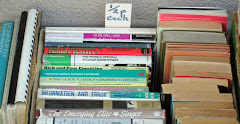The beautiful picture above of the Cairngorms by Phyllis Clair Smith is the record of an actual journey. Phyllis is a keen hill-walker but it is also an exploration of unusual materials and techniques. I was intrigued to know how she had achieved the contrasting effects of the atmospheric distance of clouds, snow(?) and the detailed textures of lichen and rock in the foreground. Phyllis explained that she had painted an acrylic base on wood (not canvas) overlaid with pencil and enamel and then rubbed the surface with sandpaper and white spirit. The foreground patterning is repetitive but with variations in the way of wall-paper. (This is not a criticism.) So much so, I was amazed that it was not some form of printing. But no, it was all done by the artist's hand. David Hockney would approve.
 |
| 'hills', (Enamel, pencil on wood) by Phyllis Clair Smith. |
Holly Prentice's seascapes and forests are a journey even more about exploring and experimenting with different material, techniques and media: ladling on wax over paintings on steel, or over photographs taken by her self-made pinhole camera. She told me she loves the 'process' of ladling on wax.
Process seems to be what interests her in her installation of film too, where the projector is more of a feature than the tiny film strip, (the film is not even projected onto the walls) though there are stills from the same film fixed on to a triptych of glass.
But Holly's inventiveness is not at the expense of an atmospheric evocation of the sea in a more painterly tradition in the dual painting of 'Edge':
 |
'Edge' by Holly Prentice. Oil paint, tape and wax on steel.
|
 |
| Pencil-case/light-box by Holly Prentice. |
Lastly Martyn McIntyre, whose work is more painterly, uses traditional materials of water-colours and oils. His interest in water-colours could be seen as old-fashioned by some. I loved them. I also love sketch-books, almost more than finished works and these are on display. Some are beautiful in themselves, objects d'art, self-made with hand-made paper, others are scruffy note-books. There is even a moleskine (which I presume was the gift of a supportive relative? Sorry, Martyn, my imagination is getting carried away.) but Martyn's work draws one in.
There is something very personal about sketch-books and I feel that I am prying but I am honoured that Martyn is happy for me to look through them and even take photographs.
The water-colour sketches in the note-books,
are mainly of landscapes. Some have artist's notes
to self re tone, foreground, distance, etc but
occasionally there are comments on the scene,
such as that the power station in one sketch is shortly to be demolished.

Interspersed are email addresses, phone numbers and lines of poetry. Not surprising that Martyn's journey is more of a personal, one could say a 'poetic' response to landscape. On one page is a response to a night sky seen from a train window:
 |
| Payne's Grey, a page from one of Martyn McKenzie's notebooks. |
As Martyn says in his Artist's Statement in his brochure, 'Drawing becomes a form of writing. The work is a kind of diary, almost autobiographical. Painting becomes a method of exploring, and reflecting.'
Martyn's vast canvas in oils 'Arrivals (II)' is a particularly striking response. The blue overwhelms the viewer, envelopping you in Rothko-style, though this is not an abstract painting but a sea-scape.
 |
| 'Arrivals (II)', oil by Martyn McKenzie |
There is a moon, sea and clouds and if you look very closely, there is a tiny red dot on the horizon, which I presume is a ship's light (starboard or port - I can never remember which is which). On the back of Martyn's card is a quote from Bachelard which is particularly relevant to 'Arrivals (II)':
'With a single poetic detail, the imagination confronts us with a new world.'
You can see more of Martyn's pictures and better photos than mine on: martynmckenzie.blogspot.co.uk/
*
Painting at ECA, 2012 is alive and well.




